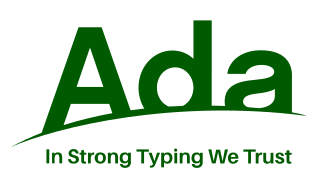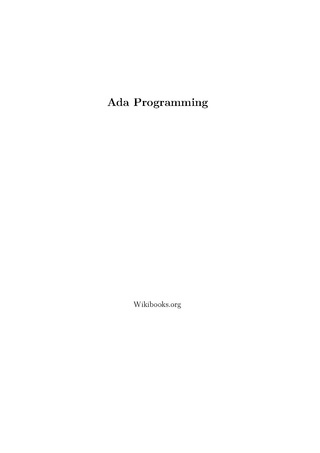
Ada is a structured, statically typed, imperative, and object-oriented high-level programming language, extended from Pascal and other languages. It has built-in language support for design by contract (DbC), extremely strong typing, explicit concurrency, tasks, synchronous message passing, protected objects, and non-determinism. Ada improves code safety and maintainability by using the compiler to find errors in favor of runtime errors. Ada is an international technical standard, jointly defined by the International Organization for Standardization (ISO), and the International Electrotechnical Commission (IEC). As of 2020, the standard, called Ada 2012 informally, is ISO/IEC 8652:2012.

VAX is a series of computers featuring a 32-bit instruction set architecture (ISA) and virtual memory that was developed and sold by Digital Equipment Corporation (DEC) in the late 20th century. The VAX-11/780, introduced October 25, 1977, was the first of a range of popular and influential computers implementing the VAX ISA. The VAX family was a huge success for DEC – over 100 models were introduced over the lifetime of the design, with the last members arriving in the early 1990s. The VAX was succeeded by the DEC Alpha, which included several features from VAX machines to make porting from the VAX easier.

OpenVMS, often referred to as just VMS, is a multi-user, multiprocessing and virtual memory-based operating system. It is designed to support time-sharing, batch processing, transaction processing and workstation applications. Customers using OpenVMS include banks and financial services, hospitals and healthcare, telecommunications operators, network information services, and industrial manufacturers. During the 1990s and 2000s, there were approximately half a million VMS systems in operation worldwide.
JOVIAL is a high-level programming language based on ALGOL 58, specialized for developing embedded systems. It was a major system programming language through the 1960s and 1970s.
MIL-STD-1750A or 1750A is the formal definition of a 16-bit computer instruction set architecture (ISA), including both required and optional components, as described by the military standard document MIL-STD-1750A (1980). Since August 1996, it has been inactive for new designs.
Oracle Rdb is a relational database management system for the OpenVMS operating system. It was originally released by Digital Equipment Corporation (DEC) in 1984 as VAX Rdb/VMS.
The Ada Conformity Assessment Test Suite (ACATS) is the test suite used for Ada processor conformity testing. A prior test suite was known as the Ada Compiler Validation Capability (ACVC).

The Ada Semantic Interface Specification (ASIS) is a layered, open architecture providing vendor-independent access to the Ada Library Environment. It allows for the static analysis of Ada programs and libraries. It is an open, published interface library that consists of the Ada environment and their tools and applications.
A United States defense standard, often called a military standard, "MIL-STD", "MIL-SPEC", or (informally) "MilSpecs", is used to help achieve standardization objectives by the U.S. Department of Defense.
VAXELN is a discontinued real-time operating system for the VAX family of computers produced by the Digital Equipment Corporation (DEC) of Maynard, Massachusetts.
Modula-2 is a structured, procedural programming language developed between 1977 and 1985/8 by Niklaus Wirth at ETH Zurich. It was created as the language for the operating system and application software of the Lilith personal workstation. It was later used for programming outside the context of the Lilith.
DDC-I, Inc. is a privately held company providing software development of real-time operating systems, software development tools, and software services for safety-critical embedded applications, headquartered in Phoenix, Arizona. It was first created in 1985 as the Danish firm DDC International A/S, a commercial outgrowth of Dansk Datamatik Center, a Danish software research and development organization of the 1980s. The American subsidiary was created in 1986. For many years, the firm specialized in language compilers for the programming language Ada.
Advanced Computer Techniques (ACT) was a computer software company most active from the early 1960s through the early 1990s that made software products, especially language compilers and related tools. It also engaged in information technology consulting, hosted service bureaus, and provided applications and services for behavioral health providers. ACT had two subsidiaries of note, InterACT and Creative Socio-Medics.

Dansk Datamatik Center (DDC) was a Danish software research and development centre that existed from 1979 to 1989. Its main purpose was to demonstrate the value of using modern techniques, especially those involving formal methods, in software design and development.

Tartan Laboratories, Inc., later renamed Tartan, Inc., was an American software company founded in 1981 and based in Pittsburgh, Pennsylvania, that specialized in programming language compilers, especially for the language Ada. It was based on work initially done at Carnegie Mellon University and gradually shifted from a focus on research and contract work to being more product-oriented. It was sold to Texas Instruments in 1996. Part of it was later acquired by DDC-I in 1998.
TeleSoft, Inc. was an American software development company founded in 1981 and based in San Diego, California, that specialized in development tools for the Ada programming language.
Verdix Corporation was an American software company active in the 1980s and 1990s and based in Fairfax County, Virginia, that specialized in language compilers for the Ada programming language.
Synergy DBL is a compiled, imperative programming language designed for business use. The language was originally called DBL; later it was referred to as Synergy Language; as of 2012 the official name is Synergy DBL. It is based on Digital Equipment Corporation’s DIBOL programming language.

Human Computing Resources Corporation, later HCR Corporation, was a Canadian software company that worked on the Unix operating system and system software and business applications for it. Founded in 1976, it was based in Toronto.
Harris Computer Systems Corporation was an American computer company, in existence during the mid-1990s, that made real-time computing systems. Its products powered a variety of applications, including those for aerospace simulation, data acquisition and control, and signal processing. It was based in Fort Lauderdale, Florida. For twenty years prior, it had been the Harris Computer Systems Division of Harris Corporation, until being spun off as an independent company in 1994. Then in 1996, Harris Computer Systems Corporation itself was acquired by Concurrent Computer Corporation.







